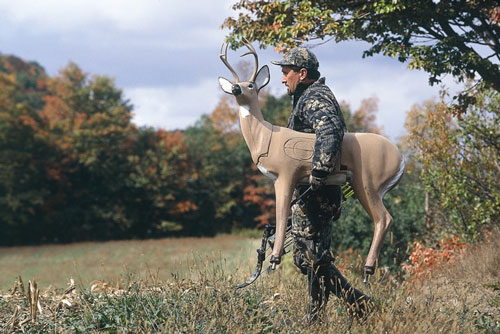Previously: Early-Season Calling
Pre-Rut Calling
 The season’s first scrapes herald the onset of the pre-rut. They appear rather suddenly, often in locations where you found them last year. Look for scrapes along logging roads and natural funnels as well as the edges of fields and swamps.
The season’s first scrapes herald the onset of the pre-rut. They appear rather suddenly, often in locations where you found them last year. Look for scrapes along logging roads and natural funnels as well as the edges of fields and swamps.
Bucks will be leaving bedding areas earlier in the afternoon now and returning to their safety zones later in the morning for one reason: They are on the prowl for the season’s first estrous does.
Scrapes lines are my favorite locations during the pre-rut. They are only hot for a week to 10 days, however, so you have to hunt them as soon as possible. The secret is to read the ancillary sign found nearby, such as tracks, scat, rubs and the direction the forest duff is kicked in order to determine when the buck is most likely to return.
An evening scrape line will often have the duff kicked back toward a thicket or other bedding area. The shiny sides of any nearby rubs will also be facing the bedding area.
Some scrape lines are short with less than a half-dozen scrapes while others can be much longer and have more than one buck working the line. I like to prowl the scrape line in the evening, ending up near the edge of the suspected bedding area by nightfall.
I will stop quite often next to a stump, rock, blow-down or large tree to call, using mostly estrous doe bleats or fawn bleats coupled with two to four tending buck grunts. For a bit of realism, use a single-purpose call coupled with a variable tube to sound like two distinct deer. I’ve easily tagged a half-dozen or more bucks in this manner.
Peak Rut
There is no doubt that the peak of the rut is the most exciting time to be afield with a grunt tube. Bucks are running back and forth across the countryside all day long now in their almost endless search for a doe in heat. Indeed, wide-racked “mystery” bucks, bucks we have never seen before, seem to pop out of nowhere, astonish us with their headgear and then disappear back into the underbrush never to be seen again.
You will know the rut has kicked in when you see bucks lingering around feeding areas preferred by family groups of does and fawns well after sunrise. They will be searching for does by scent-checking the edges of openings, and by staring off into thick-wooded areas for several moments at a time. This is a good time to give a roving buck what he is expecting to find—a family group of does and fawns. He will quickly zero in on a couple of fawn bleats followed by a doe bleat or two.
Keep your eyes and ears open, but don’t be afraid to blind call every 15 minutes or so, either. This is where a snort-wheeze vocalization can work wonders. It imitates a buck frustrated that a hot doe won’t stand still for breeding. Your rendition of a buck clicking, the sounds a buck makes just prior to actual breeding, followed by an estrous doe bleat may also bring a roving buck into bow range.
Where you call from is often the key to success. Look for hedgerows, barbed wire fence lines, dry creek beds as well as terrain features such as ravines and fingers of brush that funnel deer in and out of these feeding areas. The trick is to sneak along using available cover, stopping every 50 to 100 yards to call. Get into the habit of glassing nearby cover for a white throat patch, eye rings or swiveling ears at each stop. Rutting bucks will often stand still in thick cover waiting for an estrous doe to saunter past. If you can see him first, your chances of successfully calling him to within bow range with just a couple of estrous doe bleats are actually quite good.
If you catch a lone buck passing by just out of range, you can spice up your calling efforts by pushing a sapling back and forth as if it were being rubbed by a frustrated buck. This visual cue may push him over the edge, triggering him into immediate action.
Finally, pulling a racked buck away from an estrous doe can be a chore. A lost fawn bleat or, in desperation, even a fawn-in-distress rendition may tweak her maternal instincts and bring her to you, with that buck in tow.
Next: Late-Season Madness






